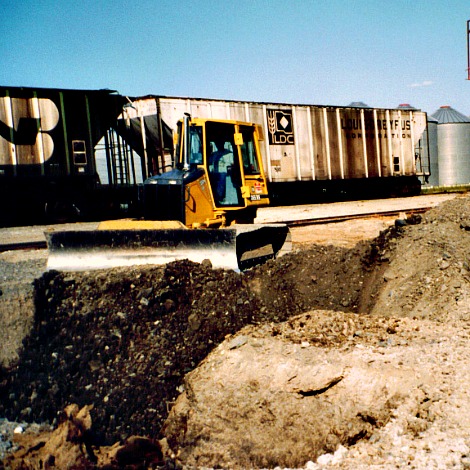We are often asked what to do with excess contaminated fill soils or “dirty dirt” from construction or redevelopment projects. Off-site reuse of excess contaminated fill is a common practice for many contractors throughout Minnesota. Thus creating a “Dirty World!”
Just about all urban fill soils in the Twin Cities have some level of contamination from historical activities conducted on the site or due to import from some other unknown site. This contaminated fill could be regulated (above MPCA concern level) or unregulated and you can’t just take this “dirty dirt” anywhere. It should be managed or disposed of in accordance with applicable regulations.
.The Minnesota Pollution Control Agency (MPCA) has recently published new guidance documents regarding Best Management Practices (BMPs) for off-site reuse of urban fill soils with contamination. Otherwise known as “unregulated fill” usually the identified contaminants in the fill are present at concentrations that are not a concern to the MPCA. Unregulated fill is not a solid waste. There is also MPCA guidance for “regulated fill” which is applicable for fill that exceeds the unregulated fill criteria
Criteria for unregulated fill?
- Fill soils must meet the following criteria to be considered unregulated:
- Free from solid waste, debris, asbestos-containing material, visual staining, and chemical odor
- Organic vapors less than 10 parts per million, as measured by a photoionization detector (PID)
- Less than 100 mg/kg diesel range organics (DRO) and/or gasoline range organics (GRO)
- Less than the MPCA’s Residential Soil Reference Values (SRVs) and Tier 1 Soil Leaching Values (SLVs) – which can be found on the MPCA website: www.pca.state.mn.us
Exclusions to MPCA’s Guidance
- Soil that is contaminated above MPCA standards.
- Debris laden soils.
- Waste material such as salvaged bituminous, crushed concrete, bricks, fly ash, etc. to be beneficially reused.
- Dredged materials.
When do you sample?
Soil should be sampled for contamination once it’s known that a potential concern exists. Maybe an old Phase I and II Environmental Site Assessment shows contamination exists but does not conclude that a cleanup was required. Just because the report says that the site is closed doesn’t mean that the contamination is gone. It may still be there and you cannot take it anywhere. If soil contamination is present (no matter what level), you have to manage or dispose of it properly.
AET can help you decide sampling requirements based on information about the property ( i.e. old gas station, dry cleaners or unknown fill source). We know what analyses to sample for and how many samples the MPCA or a landfill recommends. We use sound professional judgment when developing a sampling plan to determine whether excess soil meets the criteria for unregulated fill.
If no known or potential sources of contamination are identified during environmental due diligence and subsequent field observations, then sampling of excess soil for laboratory analyses is not necessary.
Fees for these services vary depending upon the location and volume of dirt that needs to be moved or possibly disposed at a landfill. For example, sampling fees could range from $500 to $2,000 for a 500 cubic yard stockpile, depending on where it’s located.
Movement and placement of unregulated fill (MPCA BMPs)
Unregulated fill is most suitable for use at industrial or commercial properties. However, these areas are off limits:
- Gardens where food for human/animal ingestion will be grown.
- Schools, playgrounds, daycares, and residential properties.
- A ten-foot separation distance between unregulated fill and the water table.
- Where contaminants may be transported by run-off to lakes, rivers, wetlands, or streams.
PLEASE NOTE: There may be stricter standards elsewhere. Some local units of government, may have local ordinances which restrict the off-site reuse of unregulated fill within their boundaries. Parties seeking to import unregulated fill should check.
Implementation
All parties are encouraged to use the BMPs described herein in order to make good decisions about the off-site reuse of unregulated fill. It is the responsibility of the property owners and the contractor engaged in development and construction activities to make sure that their activities include appropriate environmental due diligence and that excess soil and other materials generated by these activities are managed in an environmentally responsible manner. Planning and well written specifications will save you money in the long run.
Part Two of It’s A Dirty World can be found here: /resources/articles/2015/04/its-dirty-world-part-two/
Kate Kleiter is a hydrogeologist and former manager of AET’s St. Paul Environmental Department. If you have any questions about AET’s Environmental Services please contact Grail Cederberg, PhD by email at gcederberg@amengtest.com.


